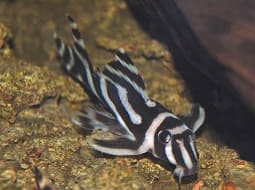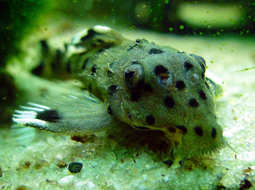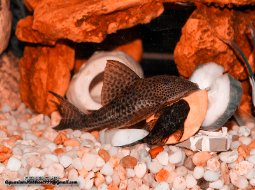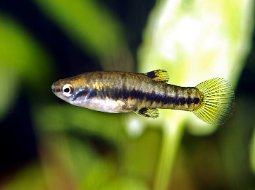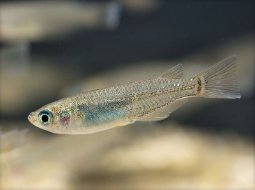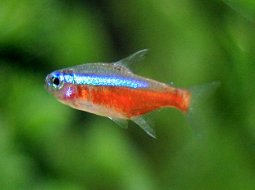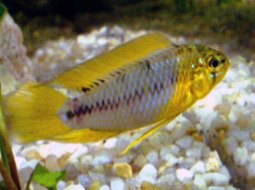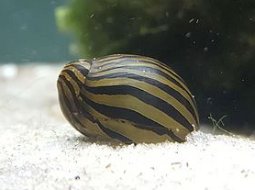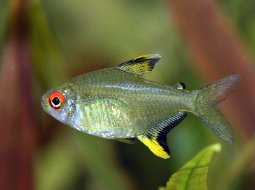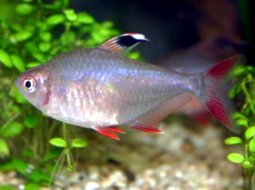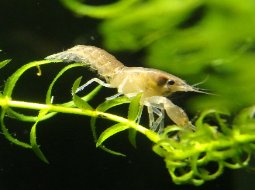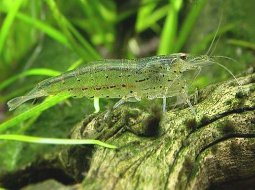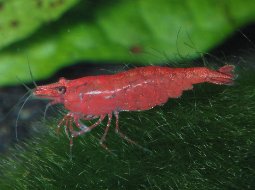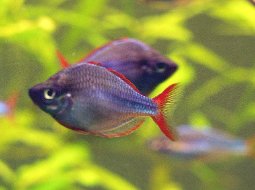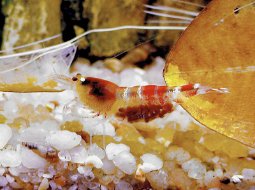
Loading Aqualapp ...
Care and Compatibility of Red-tailed Black Shark - Epalzeorhynchus frenatus
Introduction
The Red-tailed Black Shark has a slender and angular body with predominantly red and black coloration. It has a triangular and pointed caudal fin, resembling the shape of a shark's tail, hence its common name. They require an aquarium with plenty of plants and hiding places to establish their territory.
Behavior
The Red-tailed Black Shark (Epalzeorhynchus frenatus), also known as the Red-finned Shark or Red-tailed Labeo, is an active and energetic fish often found in many aquariums. It is known for its striking coloration and territorial behavior. They can be aggressive towards other fish of the same species, so it is recommended to keep them in large groups or in spacious aquariums.
Sexual Dimorphism
Sexual dimorphism in Epalzeorhynchos frenatus is minimal and difficult to distinguish. Both males and females have a similar appearance, though males may be slightly larger and display more intense colors.
Reproduction
Breeding Red-tailed Black Sharks can be challenging in the home aquarium. They are egg-laying fish, and the female deposits the eggs on substrates or plants. The parents do not care for the fry, so it is recommended to remove them after spawning to prevent them from being eaten.
Aquarium Conditions
Epalzeorhynchos frenatus, commonly known as the red-tailed black shark, requires a spacious aquarium with good water circulation and hiding areas. It prefers clean and well-oxygenated water. Aquarium décor should include rocks, driftwood, and hardy plants. Maintaining water quality is crucial and providing a balanced diet.
Feeding
They are omnivorous and accept a variety of foods, including dry foods like flakes and pellets, as well as live and frozen foods. They also enjoy vegetable matter such as algae. It is recommended to feed them multiple times a day in small portions.
Complexity
Caring for Epalzeorhynchos frenatus can be moderately challenging. They are active and territorial fish that may display aggressive behaviors towards other bottom-dwelling fish. It's recommended to keep them in groups of at least three individuals to reduce intraspecific aggression. They are omnivores and accept a variety of foods.
In case you need more help, or if you want to know into any topic related to the Epalzeorhynchus frenatus (Red-tailed Black Shark) and even any other species you can use the forums to ask what you need.
To do an analysis more detailed about coexistence and behavior of Epalzeorhynchus frenatus (Red-tailed Black Shark) use the Aquarium simulation tool, if you do this you can test different ways to combine the Red-tailed Black Shark with other fishes giving the dimensions and space on you aquarium, on this way you can known the optimal configuration for keep the fishes that you want.
You can also find out the 66 species compatible with the Epalzeorhynchus frenatus (Red-tailed Black Shark) can live together.
Note: The parameters of the water such as PH and temperature are also used to calculate the compatibility of the species.
Compatible species (66)
Compatible (5 Species)
Compatible without any restriction
El sumatrano es un pez de cardumen además que tiene un buen tamaño y es rápido, en un acuario de biotopo el Labeo no tendrá dificultad con ellos.
Similar Sizes (1 Species)
They can coexist if they are the same size or very similar sizes, it does not work in all cases, there may be exceptions.
With Reservation (13 Species)
Compatible in some cases, it depends on the nature and personality of the fish.
Las especies territoriales por lo general pueden convivir con especies protegidas con coraza, ya que no pueden hacerles daño por su dura piel, lo que si hay que tener en cuenta es tener un acuario con dimensiones favorables para que cada pez pueda delimitar un territorio, ya que la mayoría de peces acorazados son también peces de fondo y les gusta estar buscando lugares donde ocultarse.
Showdown over territory (24 Species)
Fish can live together as long as the space is spacious enough to delimit a territory, otherwise there may be aggressions for competing for the territory.
Los peces territoriales por lo general pueden convivir con peces protegidos con coraza, ya que no pueden hacerles daño por su dura piel, lo que si hay que tener en cuenta es tener un acuario con dimensiones favorables para que cada pez pueda delimitar un territorio, ya que la mayoría de peces acorazados son también peces de fondo y les gusta estar buscando lugares donde ocultarse.
Territorial fish can usually live with fish protected with armor, since they cannot harm them because of their tough skin, what must be taken into account is to have an aquarium with favorable dimensions so that each fish can delimit a territory, since that most armored fish are also bottom fish and they like to be looking for places to hide.
Territorial fish can usually live with fish protected with armor, since they cannot harm them because of their tough skin, what must be taken into account is to have an aquarium with favorable dimensions so that each fish can delimit a territory, since that most armored fish are also bottom fish and like to be looking for places to hide.
Considerable size difference (21 Species)
They can coexist while they are similar in size or the size difference is not very abysmal, since as the fish grows it increases the chances of eating its partner that did not grow much.
Food competition (1 Species)
They can live together but you have to be careful since it is likely that the fastest fish will take all the food and leave nothing for their partners who are slow swimmers, so you have to make sure that everyone can eat.
Compatible if space is enough (1 Species)
They can coexist together if the aquarium they share is large and spacious enough for both species to feel good, as some fish may attack others to feel that they have little space and try to eliminate the competition.
Red-tailed Black Shark
Epalzeorhynchus frenatus
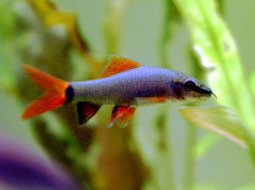
- Ph: 6.5 - 8
- Temperature (c°): 20 - 26
- Measures: 13 cm - 15cm
- Aquarium Capacity:
75 Liters - 20 Gallons - Alimentación: Omnivores
- Colores: Black, Blue, Red
- Comportamiento: Aggressive, Likes to take refuge, Territorial
- Habitad: Asian
- Morfología: Bright colors
- Preferencias del Acuario: Natural plants, Sand
- Tamaño: Medium
- Taxonomía: Fish
- Tipo de Agua: Sweet water
- Velocidad de nado o movimiento: Fast
- Zona de Nado: Aquarium background

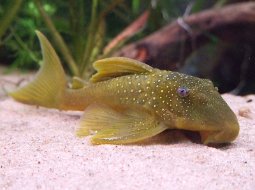


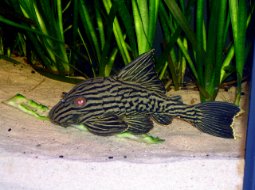
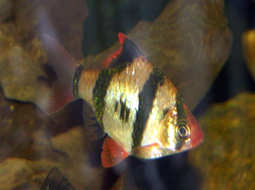

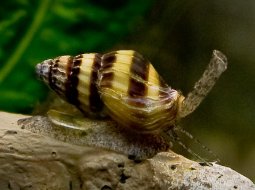
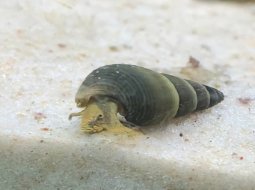

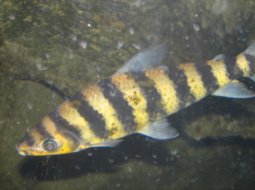


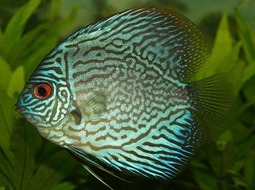

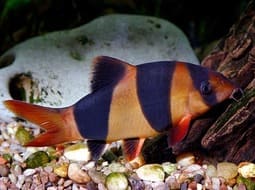
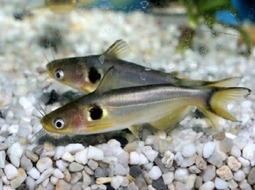
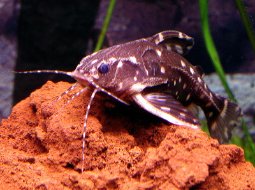
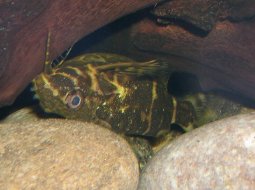
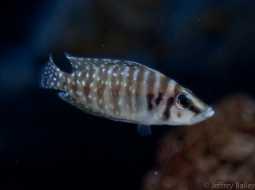
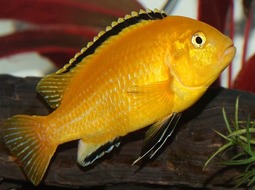
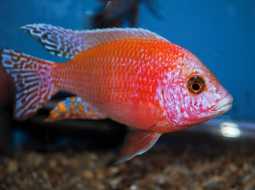
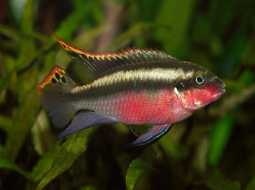
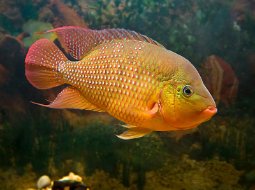
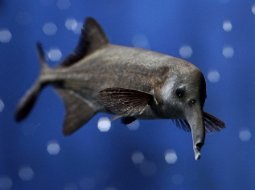

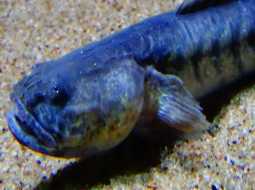
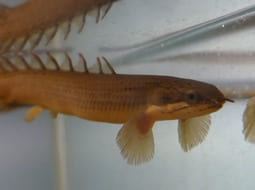
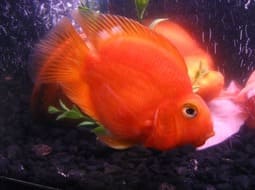
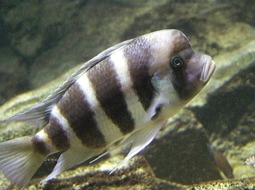
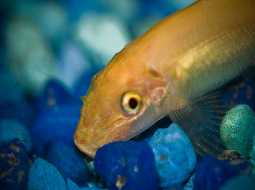
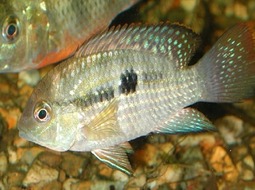
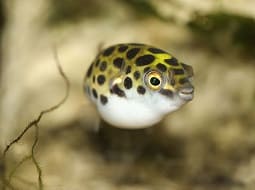
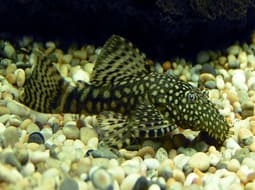
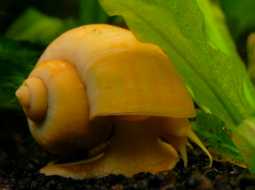

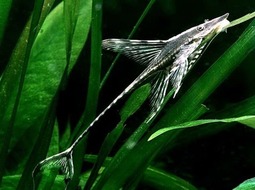
.jpg)
